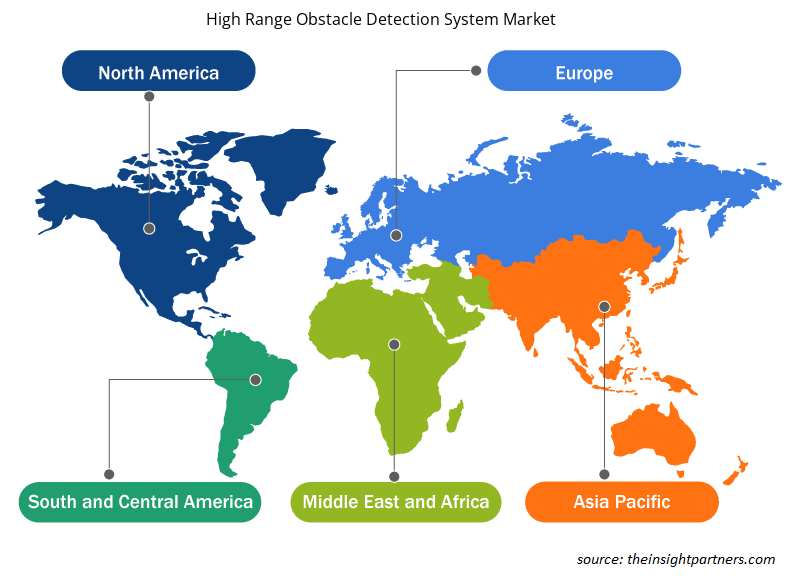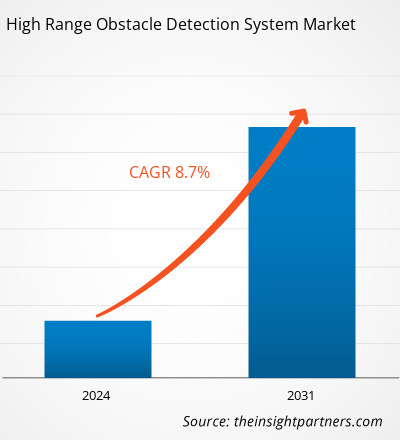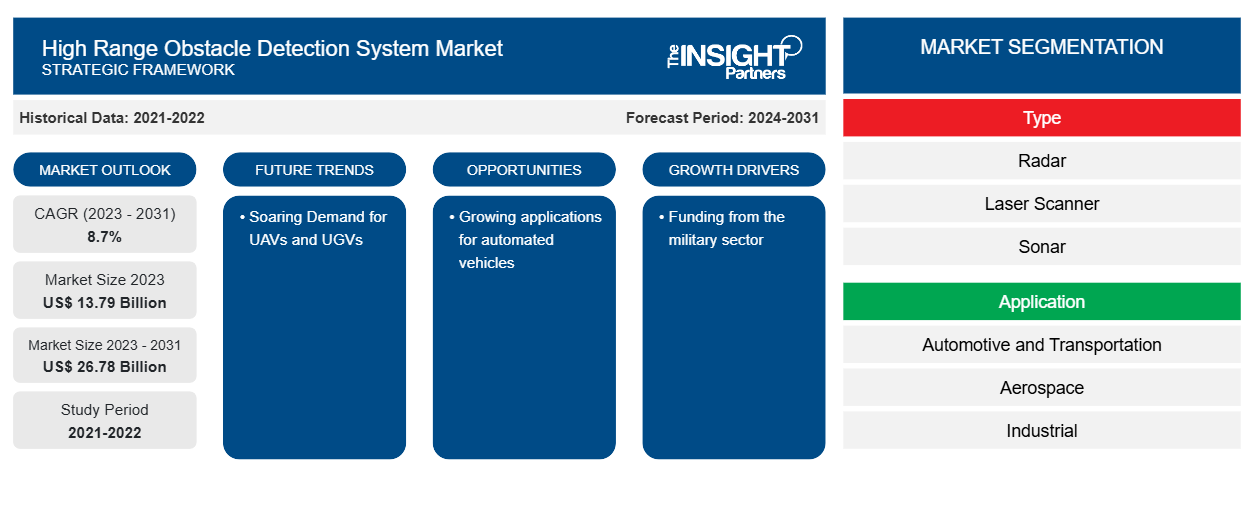長距離障害物検知システムの市場規模は、2023年の137億9,000万米ドルから2031年には267億8,000万米ドルに達すると予測されています。市場は2023年から 2031年にかけて8.7%のCAGRを記録すると予想されています。自動車分野での効率的な障害物検知システムに対する需要の高まりと、さまざまな業界でのLiDAR技術の採用は、長距離障害物検知システムの市場動向の鍵となる可能性が高いです。
長距離障害物検知システム市場分析
世界の高範囲障害物検知システム市場は、自動車、ロボット工学、航空宇宙、防衛など、さまざまな産業分野での応用により、急速に拡大すると予想されています。世界の高範囲障害物検知システム市場の成長を牽引する主な要因には、自律走行車の需要の高まりと衝突検知の必要性の増加などがあります。センサーと関連コンポーネントの技術的進歩により、市場参加者に大きなチャンスが生まれると予想されています。
長距離障害物検知システム市場の概要
信頼性の高い高範囲障害物検出は、自動運転車などの高速で移動する安全性が重要なプラットフォームが危険にリアルタイムで対応する上で不可欠です。高範囲障害物検出システムは、木や建物などの障害物を遠くから検出します。レーダー、カメラ、レーザーなどのセンサーを使用して、環境内の高さや物体を測定し、障害物が検出されるとユーザーに通知します。これらのシステムは、車両や航空機のナビゲーション、軍事検出、地雷の回避など、さまざまな用途で使用されています。
要件に合わせてレポートをカスタマイズする
このレポートの一部、国レベルの分析、Excelデータパックなど、あらゆるレポートを無料でカスタマイズできます。また、スタートアップや大学向けのお得なオファーや割引もご利用いただけます。
-
このレポートの主要な市場動向を入手してください。この無料サンプルには、市場動向から見積もりや予測に至るまでのデータ分析が含まれます。
長距離障害物検知システム市場の推進要因と機会
軍事部門からの資金提供が市場を有利にする
長距離障害物検知システムは、レーダーと視覚技術の両方を使用して、遠くから障害物や危険を検出する高度な検知システムです。ドローン、地上車両、船舶などの軍事用途で使用されます。このシステムは、リアルタイムで障害物を検出するのに役立つ高度なセンサーを使用します。このような高度な技術は、ドローン、無人水上車両(USV)などの効率を向上させるのに役立ちます。軍事分野でのこの技術のこのような使用のために、市場プレーヤーは技術的に高度なソリューションを開発するために軍から資金提供を受けています。たとえば、2023年12月、KEF Roboticsは米国国防総省から資金提供を受け、米軍のテザードローン向けのAI対応障害物検知ソリューションを開発しました。
自動運転車の用途拡大
自動運転車と自動運転システムは、より安全で効率的な輸送手段をもたらすため、市場が拡大しています。自動運転車は障害物検知システムの需要を生み出し、さらに障害物を正確に検知するための高範囲障害物検知システムの需要を促進します。このソリューションを採用すると、車両は障害物を素早く検知し、それに応じて反応します。この機能により、自動運転車の安全性が向上します。
長距離障害物検知システム市場レポートのセグメンテーション分析
高範囲障害物検知システム市場分析の導出に貢献した主要なセグメントは、タイプとアプリケーションです。
- タイプに基づいて、市場はレーダー、レーザースキャナー、ソナー、LiDAR に分類されます。LiDAR セグメントは、最も高い CAGR で成長すると予想されています。
- 用途別に見ると、市場は自動車・輸送、航空宇宙、産業、海洋、その他の用途に分かれています。自動車・輸送部門は2023年に大きな市場シェアを占めました。
地域別高範囲障害物検知システム市場シェア分析
高範囲障害物検知システム市場レポートの地理的範囲は、主に北米、アジア太平洋、ヨーロッパ、中東およびアフリカ、南米/中南米の 5 つの地域に分かれています。
アジア太平洋地域は、最も高い CAGR で成長すると予想されています。この地域では、産業用ロボットの使用増加に伴い、高範囲障害物検出市場が成長しています。自律走行車やドローンにおける高範囲障害物検出の幅広い応用により、市場の成長がさらに促進されます。
長距離障害物検知システム市場の地域別洞察
予測期間を通じて高範囲障害物検知システム市場に影響を与える地域的な傾向と要因は、Insight Partners のアナリストによって徹底的に説明されています。このセクションでは、北米、ヨーロッパ、アジア太平洋、中東およびアフリカ、南米および中米にわたる高範囲障害物検知システム市場のセグメントと地理についても説明します。

- 高範囲障害物検知システム市場の地域別データを入手
長距離障害物検知システム市場レポートの範囲
| レポート属性 | 詳細 |
|---|---|
| 2023年の市場規模 | 137億9000万米ドル |
| 2031年までの市場規模 | 267.8億米ドル |
| 世界のCAGR(2023年~2031年) | 8.7% |
| 履歴データ | 2021-2022 |
| 予測期間 | 2024-2031 |
| 対象セグメント |
タイプ別
|
| 対象地域と国 |
北米
|
| 市場リーダーと主要企業プロフィール |
|
市場プレーヤーの密度:ビジネスダイナミクスへの影響を理解する
長距離障害物検知システム市場は、消費者の嗜好の変化、技術の進歩、製品の利点に対する認識の高まりなどの要因により、エンドユーザーの需要が高まり、急速に成長しています。需要が高まるにつれて、企業は提供を拡大し、消費者のニーズを満たすために革新し、新たなトレンドを活用し、市場の成長をさらに促進しています。
市場プレーヤー密度とは、特定の市場または業界内で活動している企業または会社の分布を指します。これは、特定の市場スペースに、その市場規模または総市場価値に対してどれだけの競合相手 (市場プレーヤー) が存在するかを示します。
高範囲障害物検知システム市場で事業を展開している主要企業は次のとおりです。
- BAEシステムズ
- ブリックフェルト株式会社
- コリンズエアロスペース
- ハネウェルインターナショナル株式会社
- ifmエレクトロニック有限会社
- リボックス
免責事項:上記の企業は、特定の順序でランク付けされていません。

- 高範囲障害物検知システム市場のトップキープレーヤーの概要を入手
長距離障害物検知システム市場のニュースと最近の動向
長距離障害物検知システム市場
主要な企業出版物、協会データ、データベースを含む一次調査および二次調査後の定性的および定量的データを収集することによって評価されます。以下は、市場における動向の一覧です。
- 2023 年 5 月、クルージュのボッシュ エンジニアリング センターは、クルージュ=ナポカ公共交通会社 (CTP) の車両群の一部である路面電車に、ボッシュが開発した衝突警告システム「路面電車前方衝突警告 (TFCW)」を設置すると発表しました。このシステムは、聴覚と視覚による警告を提供することで、危機的な状況で路面電車の運転手を支援し、路面電車の運転手、乗客、その他の交通関係者の安全性を高めます。路面電車衝突警告システムは、特に交通渋滞や視界不良の状況で、線路上の障害物についてタイムリーに警告することで、危機的な状況で運転手をサポートします。これにより、運転手は事故を回避したり、被害を大幅に軽減したりできます。(プレスリリース、2023 年)
長距離障害物検知システム市場レポートの対象範囲と成果物
「高範囲障害物検知システム市場規模と予測(2023〜2031年)」レポートでは、以下の分野をカバーする市場の詳細な分析を提供しています。
- 対象範囲に含まれるすべての主要市場セグメントの世界、地域、国レベルでの市場規模と予測
- 市場の動向(推進要因、制約、主要な機会など)
- 今後の主な動向
- 詳細なPEST/ポーターの5つの力とSWOT分析
- 主要な市場動向、主要プレーヤー、規制、最近の市場動向を網羅した世界および地域の市場分析
- 市場集中、ヒートマップ分析、主要プレーヤー、最近の動向を網羅した業界の状況と競争分析
- 詳細な企業プロフィール
- 過去2年間の分析、基準年、CAGRによる予測(7年間)
- PEST分析とSWOT分析
- 市場規模価値/数量 - 世界、地域、国
- 業界と競争環境
- Excel データセット
最新レポート
お客様の声
購入理由
- 情報に基づいた意思決定
- 市場動向の理解
- 競合分析
- 顧客インサイト
- 市場予測
- リスク軽減
- 戦略計画
- 投資の正当性
- 新興市場の特定
- マーケティング戦略の強化
- 業務効率の向上
- 規制動向への対応























 無料サンプルを入手 - 長距離障害物検知システム市場
無料サンプルを入手 - 長距離障害物検知システム市場